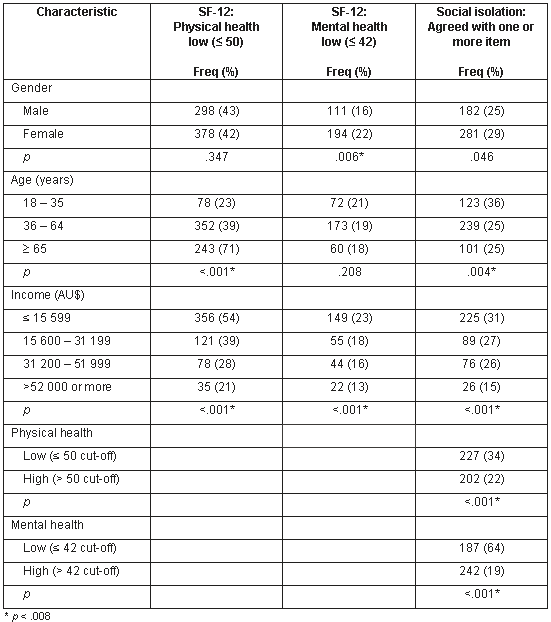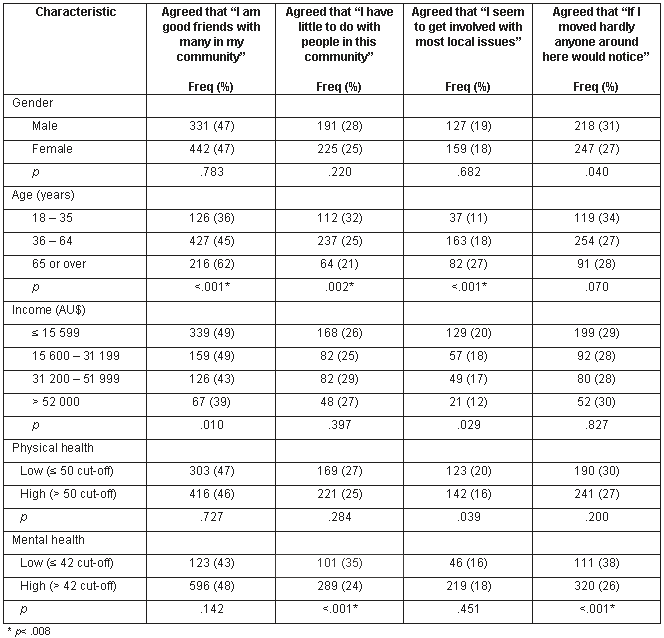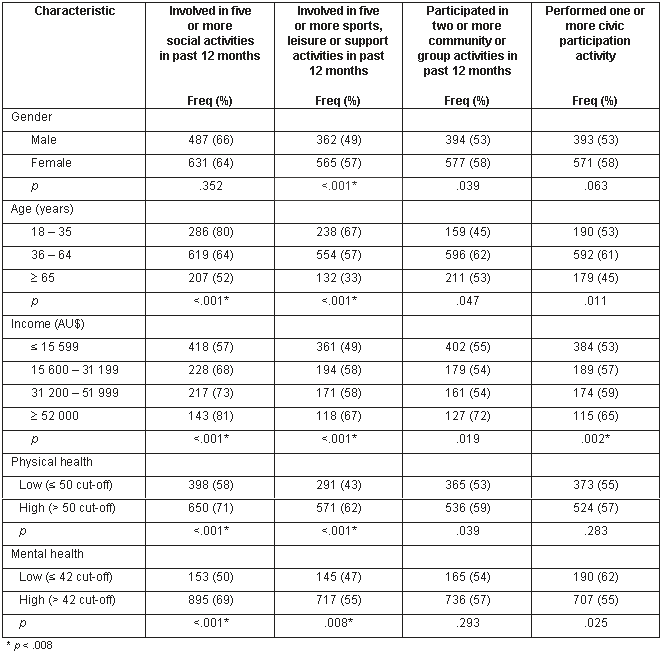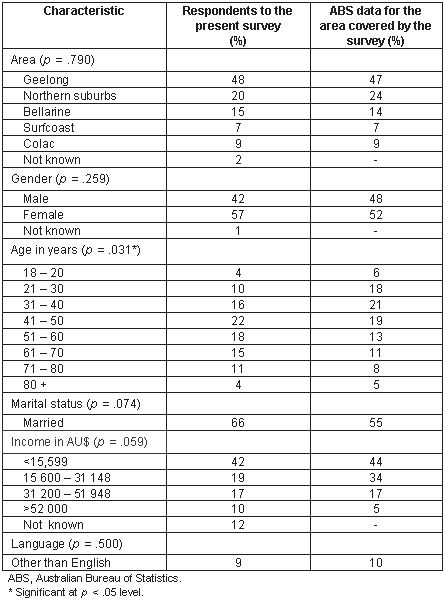Introduction and background
Social capital refers to the processes between people that establish networks, norms and trust, enabling coordination and cooperation for mutual benefit. The literature provides evidence of a relationship between social capital or community participation and health1-3. Social capital or social connectedness serves to empower the community and enhance the health of the people who form the community4. Social capital is created as a by-product of social relationships and maintains the property of non-excludability - meaning its benefits are available to all those living within the community and access is not restricted5. Engaging in community activities has been shown to result in a direct improvement in the health and wellbeing of many people by enabling them to overcome perceived isolation and powerlessness6. Research indicates that engaging in a high number of quality social contacts is correlated with a low level of morbidity and with increased life expectancy4.
An Australian study conducted by Onyx and Bullen in 1997 measured social capital in five communities, focusing primarily on identifying attitudes, behaviours and knowledge related to social capital.7 Results revealed that the three strongest elements in defining social capital were: (i) participation in local community organisations and events; (ii) personal proactivity in a social context; and (iii) feelings of trust and safety. However that study did not make correlations between self-perceptions of health or wellbeing and social connectedness.
In another Australian study by Baum et al, the connection between health and community participation was investigated8. The authors completed a randomised cross-sectional survey of the population of the western suburbs of Adelaide in South Australia. Findings from the study indicated that in a metropolitan area levels of participation are structured according to several demographic factors, and that social exclusion is likely to be prevalent for certain groups. People with low income and educational levels displayed a relative lack of involvement in social and civic activities. The gender and age of urban participants were also associated with different patterns and types of participation. For example, women were more likely to be involved in social activities than men, and older people were involved in different types of civic and community group activities than younger people8. The authors argued that knowledge of the pattern of participation, which is an important aspect of social capital and an indicator of a healthy community, should inform social and health policy making8. Given that there are health differentials between rural and metropolitan populations9 but little published information about participation in rural locations, it is important that research in the area of health and participation is conducted in a range of geographic locations.
Study objective
The present study examined the relationship between levels of community participation and health in a rural and regional setting by surveying people living in the Barwon and Otway regions of Victoria, Australia. In order to measure both the quality and structure of social relations or participation, a number of measures of participants' opinions about their community were included. These items reflect the norms of trust and reciprocity that have been characterised as particularly important in the measure of social capital10. The research questions were:
- In a rural and regional area setting, is there a relationship between levels of participation in a community, the quality of involvement in the community and self-assessed health status?
- In a rural and regional setting, what is the association between a number of demographic factors and the levels of participation and quality of involvement in a community?
Method
This descriptive correlational survey was based on a mailed, written-response questionnaire instrument. Relationships between variables such as gender, age, income and self-perceived health and participation activities were examined. The questionnaire was originally developed by Baum et al...."8 using a combination of two pre-existing measures and further demographic questions. Health status was measured using the SF-1211, which provides a measure of physical and mental health status.
Types and levels of participation were ascertained and a number of categories of participation were identified: social activities; sport, leisure or support activities; community or group activities; and civic activities. Items on feelings of social isolation, assisting and receiving assistance from neighbours, and feelings about one's community were also included.
A sample of 6000 people aged 18 years and over was randomly selected from the electoral rolls of two electoral divisions in the Barwon sub-region. Consequently, the sample included people living in regional and rural environments. A single mail-out was conducted. In order to assure participants that the survey was completely anonymous, there were no follow-up contacts with non-respondents. No identifying information was included on the survey forms. It was felt that anonymity was important to ensure that participants felt comfortable disclosing details about their health and involvement in a range of activities. Ethics approval was obtained from the Deakin University Human Ethics Committee and the Victorian Department of Human Services Ethics Committee.
Data analysis
The data were analysed using SPSS 10 (SPSS Inc, Chicago, IL, USA). In the following results, some percentages will not sum to 100 due to rounding. Chi-squared tests were used to determine associations between key variables and demographic data. Differences between participants from different sex, age, income, and physical and mental health groups were examined for selected items. The gamma statistic was used for the ordinal variables (age and income). Due to the changing number of 'no response' to items, the number of participants included in each analysis varied and is not presented in the tables. A significance level of .008 was appropriate, with a Bonferroni correction of 6 due to multiple tests being conducted on each dependent variable. In the tables, an asterisk indicates that significance at the level of p <.008 is reached.
Health status
Health status was measured using the SF-12 scale, which provides a measure of self-assessed physical and mental health. The SF-12 is a shorter version of the SF-36. In calculating physical and mental health scores, items are weighted using US general population weights, and standardised to a mean of 50 and a standard deviation of 1012. Similar to previous Australian research, a cut-off score of 50 was used for physical health and a cut-off of 42 for mental health, with scores below these figures indicating low physical and mental health, respectively8. As recommended, where a response for any of the twelve SF-12 items was missing, no SF-12 score was calculated12.
Results
Response rate
Of the 6000 questionnaires mailed out, a total of 96 were returned-to-sender because the intended recipient was unknown at the given address. Of the remaining 5904 questionnaires, 11 were returned uncompleted, and 1837 were returned completed, giving an anticipated response rate of 31%. The exclusion of questionnaires from participants whose reported postcodes were outside the targeted region resulted in a final sample of 1752.
Demographic characteristics of the sample
The sample of 1752 people consisted of 990 females (57%) and 739 males (42%); for 23 participants (1%) sex was undisclosed. The age of participants ranged from 18 to 98 years. The mean age was 50.53 years (SD = 17.19).
As shown in Table 1, 46% of participants had completed only secondary school education, 66% were married, 33% were employed full time and 42% reported their income in the last financial year to be $15 599 or less. Fifty-one per cent of participants were outright or joint owner of their home. English was the main language spoken at home by 89% of participants.
Table 1: Demographic characteristics of participants in the health status and rural community participation study

Health
Participants (n = 1752) were asked how they would describe their own health in general. The majority rated their health as 'excellent' (16%) or 'very good' (39%), with a further 30% rating their health as 'good' and 15% rating it as 'fair' or 'poor'.
SF-12 scores: SF-12 scores were calculated for 1602 participants. Physical health scores on the SF-12 ranged from 16.67 to 66.88, with a median score of 52.09. Mental health scores ranged from 14.91 to 69.11, with a median score of 43.47. Over half of the participants (57%) obtained a physical health score above the cut-off of 50. Only 18% obtained a score below the mental health cut-off of 42. Symptoms of depression could be expected in those scoring less than 42.
SF-12 scores and demographic variables: Scores on the SF-12 physical health measure decreased significantly with increasing age (Chi square (2 degrees of freedom, n = 1579) = 170.89, p = <.001). The relationship between the SF-12 mental health measure and age was not statistically significant; however, there was a trend for mental health scores to increase with increasing age.
Table 2 indicates significant age and income differences in the proportion of participants who scored in the low range on the SF-12 physical health measure. Older participants and those with lower incomes were more likely to be in the lower scoring group than younger participants or those with higher incomes, respectively. For the SF-12 mental health measure, females were significantly more likely to score in the low range than males, as were participants with low incomes.
Table 2: Factors related to health status and social isolation

Quality of involvement in the community
Social isolation: Participants were asked how many people they could turn to for help and comfort if they had a serious personal crisis. Only 3% indicated there was no-one they could turn to, while 26% indicated one to two people, 31% indicated three to four people, and 39% indicated five or more people.
Responses to five statements presented in the survey relating to social isolation were summed. Seventy-two per cent of participants did not agree with any of these items. A greater proportion of younger participants agreed with one or more of the social isolation items than did older participants, suggesting they experienced some social isolation (Table 2). Participants with low incomes, and those with low physical and mental health scores as measured by the SF-12, were significantly more likely to agree with one or more of the social isolation items, indicating that they experienced some isolation.
Knowing people and views about the community: Almost half of the participants (48%) indicated that they 'know a few people in my neighbourhood, but most are strangers', while 34% indicated that they 'know many of the people living in my neighbourhood'. Both age and mental health were significant in the questions relating to participants' views on their community (Table 3).
Table 3: Factors related to thoughts about community

Activities involvement
Social activities: A series of items asked participants to indicate how often they had performed each of 14 social activities. The most common social activities participated in at least once per month over the past 12 months were: talking to friends or family on the phone (95%); visiting family or family visiting them (81%); and visiting friends or friends visiting them (80%).
Sport, leisure or support activities: Participants were asked to indicate how often they had performed each of 14 sport, leisure or support activities. The most common sport, leisure or support activities participated in at least once per month over the past 12 months were: walking (97%); reading (86%); and gardening (75%).
Community or group activities: A number of items asked participants about involvement in 13 community or group activities in the past 12 months. The most frequent response was making a donation (78%), followed by fundraising activity (28%) and involvement in a volunteer organisation (25%).
For involvement in social activities and involvement in sports, leisure or support activities, the youngest age group, participants with a high income and those with high physical and mental health scores were all likely to have been involved in five or more activities in the past 12 months (Table 4). Females were more likely than males to have been involved in five or more sports, leisure or support activities.
Civic participation
Civic activities: Participants were asked about seven types of civic activities (eg writing a letter to the council or contacting the local member of parliament). Rates of civic participation in the past year were quite low, ranging from 5% to 15%, with the exception of signing a petition, an activity reported by 47% of participants. The only demographic variable found to be associated with civic activity was income: participation in one or more civic activities increased with income (Table 4).
Table 4: Factors related to participation in social, sports, leisure and support, community or group activities and civic activities

Low participators
Levels of participation in the four different types of activities were combined. Eleven per cent of participants (n = 188) were classified as low participators in all four types of activities. These participants were low participators in: social activities (participated in four or less activities once a month in the past 12 months); sport, leisure or support activities (participated in four or less activities once a month in the past 12 months); community and group activities (participated in none or only one in the past 12 months); and civic activities (participated in none in the past 12 months). Low participators were more likely to be older participants, to have a low income and to have low scores for both physical and mental health (data not shown).
Discussion
Relationship between participation, quality of involvement in the community, and health
The level of involvement of participants in this study in community, group or civic activities was generally quite low, which is consistent with previous Australian data8. A comparison of the demographic characteristics of the sample with the ABS data for the area covered by the survey indicates that there are several differences between the two groups, although only one of these (age) was statistically significant (Table 5). Response rates improved with increasing age. A greater proportion of females returned the survey than males. The trend for women, and for older persons, to have higher response rates has been noted in other research conducted in the area13.
Table 5: Comparison of survey respondents with ABS data for the area.

The present research found an association between several types of participation and self-assessed physical and mental health. Participants who indicated disengagement with their local community were more likely to score in the low range for the mental health measure than participants who indicated greater community involvement. This finding is consistent with the literature6, and is important because it demonstrates that this relationship is found in a rural and regional setting. The items measuring social isolation indicate that there is a small group of participants who feel isolated in their community. These participants were more likely to be young, to have a low income, and to have low physical- and mental health scores.
While there was an association between poorer physical and mental health and both lower participation in a range of activities and social isolation, it is not possible to infer the direction of this relationship from these data. There is, however, evidence in the literature of the link between social connectedness and health6. For example, this link is clearly present in people's subjective experiences of health. Having good social relationships and experiencing a connectedness to one's community have been listed as two of the six categories that summarise people's experiences of health in cross-cultural studies6.
Relationship between demographic variables and participation and quality of involvement in the community
Of some concern is the association between participation in social, sports, leisure, support and civic activities and income. Participation in all of these areas was found to increase with income. A negative relationship between high and low incomes and the level of investment in social capital has been reported in the literature5,8. Both physical and mental health were also associated with income, with higher numbers of participants with lower incomes scoring in the lower range for self-assessed physical and mental health. This reflects the acknowledged association between socioeconomic status and health that has been reported in Australia and other countries14. The present study indicates that the same relationship between health, income and community participation found in a metropolitan population8 exists in a rural and regional population. It is important to understand the implications of socioeconomic status in relation to health and social connectedness within a community. It is clear that the Barwon region is not immune from the social costs of economic inequality15. The repercussions of the relationship of health with income and community participation may be extremely important in the context of regional and rural populations, given that they may be more disadvantaged than metropolitan populations.
A similar finding in relation to low rates of civic participation and the association between involvement in civic activities and high income was also reported by Baum et al8 and has negative implications for the empowerment of the community and the health benefits that follow6. Being involved in civic activities tends to empower individuals: such involvement may contribute to an individual's sense of control over aspects of his or her environment and sense of inclusion in important decision-making processes. The link between empowerment and health has been demonstrated previously16. Thus, the low levels of civic participation found in the present research are problematic for the health of the community in general.
These data indicate that older people in the region were less likely than those in the younger age group to be involved in social activities or in sports, leisure or support activities. A higher percentage of the older age group than the younger also obtained low scores on the SF-12 for physical health. Thus, the relationship between age and some types of participation may be confounded by health. At the same time, the data provide some indication that young people are less involved in their community. For example, a smaller percentage reported being good friends with many in their community, or that they get involved with most local issues. In addition, a higher percentage of the youngest age group indicated that they have little to do with people in their community. The youngest age group also showed a greater trend towards social isolation than did older people. Thus, there is a tendency for the younger age group to actively participate in some types of activities, but to be less involved members of their community than are older people. It is not possible from the present data to establish whether this behaviour is typical of younger age groups, or whether involvement with the community will occur as these people age. Further, it is unclear whether this is a new trend, and involvement in social and sport activities will continue to be more important than involvement in the community for this group. This finding raises the question of whether these young people will ever become more involved in their community.
Limitations
This research provided valuable information on the participation and community involvement of a large sample of residents of a rural and regional area in Australia. Some limitations of this research should be noted, however. The response rate in this study of 31% was quite low, but expected, because only a single mail-out was conducted. A higher response rate of 64% was achieved by Baum et al8 who sent three reminders to people who were late returning their survey form.
The proportion of participants in the sample who speak a language other than English at home was similar to that of the population of the area, suggesting that people from a non-English-speaking background were well represented in this research. However, the questionnaire was a lengthy document written in English only, thus individuals who were not fluent in English were disadvantaged. Another limitation is that individuals who were not sufficiently literate to complete the questionnaire could have been under-represented in the sample.
Conclusion
This research extends our knowledge of the importance of social connectedness as applied in a rural and regional setting. The association found between health status and various types of participation and involvement in the community suggests there is a need to increase participation within the community in general as a means of enhancing health in rural and regional settings. The relationship between age, participation and health is complex and needs further exploration. Specifically, it is not known whether poor health reduces community participation or whether reduced community participation results in a poor level of health. Qualitative research investigating the factors that promote or inhibit the participation of individuals across a range of activities would be informative.
In particular, this research suggests that the groups of people of most concern are those who have low incomes, those aged over 65 years, those who may be defined as being in poor physical health and those who may be defined as being in poor mental health. Further work is required to determine whether increasing such individuals' contact with others in their community would increase their levels of self-reported physical and mental health.
Current research suggests that developing and implementing strategies to promote people's engagement with and involvement in their local community is one important way of promoting the health of the community as a whole. All levels of government as well as non-government agencies potentially have a role to play in this process.
Acknowledgements
This project was funded by the Barwon Primary Care Partnership Alliance. The authors gratefully acknowledge the contribution of Sandy Austin and Sharon Brady from the Barwon Primary Care Partnership Alliance to the planning and implementation of this project. The authors acknowledge the contribution of all of the participants who completed the questionnaire. Without them, this research would not have been possible.
References
1. Rifkin SB. Lessons from community participation in health programmes. Health Policy and Planning 1986; 1: 240-9.
2. Baum F, Nodra C, Bush R et al. Volunteering and social capital: an Adelaide study. Australian Journal of Volunteering 1999; Feb: 15-22.
3. Baum F, Kalucy E. The epidemiology of caring: the pattern in a South Australian suburban population. Australian Journal of Aging 1992; 11(3): 3-8.
4. Rosenfeld ER. Social support and health status: a literature review. Adelaide, SA: South Australian Community Health Research Unit, 1997.
5. Kawachi I, Kennedy BP, Lochner K et al. Social capital, income inequality, and mortality. American Journal of Public Health 1997; 87: 1491-8.
6. Labonte R. Power, participation and partnerships for health promotion. Carlton South, Vic: VicHealth, 1997.
7. Onyx J, Bullen P. Measuring social capital in five communities in NSW: an analysis. Sydney, NSW: Centre for Australian Community Organisations and Management, 1997.
8. Baum FE, Bush RA, Modra CC et al. Epidemiology of participation: an Australian community study. Journal of Epidemiology and Community Health 2000; 54: 414-23.
9. Australian Institute of Health and Welfare (AIHW). Australia's health, 2002. Canberra, ACT: AIHW, 2002.
10. Stone W. Measuring social capital. Towards a theoretically informed measurement framework for researching social capital in family and community life. Melbourne, Vic: Australian Institute of Family Studies, 2001.
11. Ware J, Kosinski M, Keller SD. A 12-item short-form health survey: construction of scales and preliminary tests of reliability and validity. Medical Care 1996; 34: 220-33.
12. Ware JE, Kosinski M, Keller SD. How to score the SF-12 Physical and Mental Health Summary Scales. Rhode Island, NY: Quality-Metric Incorporated, 1998.
13. Clarke V, Savage S, Hanna B, Neilson P, Cox H. Health promoting behaviours of residents of government housing tenants. 2001. Geelong, Vic: Deakin University and Department of Human Services (Barwon-South Western Region), 2001.
14. Turrell G, Mathers CD. Socioeconomic status and health in Australia. Medical Journal of Australia 2000; 172: 434-8.
15. Kawachi I, Kennedy B, Wilkinson, R. The society and population health reader: income inequality and health. New York: The New Press, 1999.
16. Wallerstein N. Powerlessness, empowerment, and health: Implications for health promotion programs. American Journal of Health Promotion 1992; 6: 197-205.

